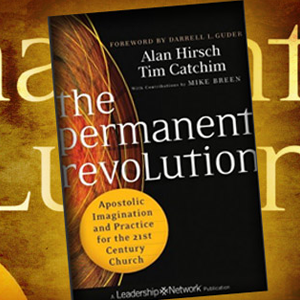An article by JR Woodward
In this literary review of Alan Hirsch and Tim Catchim’s The Permanent Revolution: Apostolic Imagination and Practice for the 21st Century Church, I will give my understanding of the basic thesis of the book, then share my thoughts, highlighting the parts of the book that I found helpful and want to remember. Following will be my critique, and finally recommendation.
Hirsch and Catchim successfully make the case that the Church of Jesus Christ has been designed with “built-in, self-generative capacities” for world transformation. They contend that if we can recapture the dynamics of apostolic movement, built on the fivefold ministry, then we can become a part of the permanent revolution empowered by God himself.
My Thoughts
The Permanent Revolution is the definitive book when it comes to understanding apostolic ministry today and it is an imperative read if you want to develop a deeper movemental mindset.
Let me give you some reasons why.
Ephesians 4:1-16: Frameworks for Ministry
In examining the first part of the book Ephesians 4:1-16: Frameworks for Ministry, I found the first chapter to be an absolute jewel, worth the price of the book itself. Within this one chapter you will find wisdom that has the potential to catalyze the congregation you serve into a whole new level of calling. Understanding the five-fold ministry from a creation and redemptive order, brings a perspective that I have been able to use with both my Christian and non-christian friends. As a person who desires to see people discover and live out their calling in life, the chart and explanation of how the various gift lists (I Cor. 12, Rom. 12, and Ephesians 4) work together are elements I have put on my own tool belt for everyday use.
As someone who has thought about, written about, and practiced a five-fold ministry since 1998, I found that looking at the five-fold through the metaphor of vocational intelligences brings a depth and clarity to the five-fold that is extremely practical and has the potential to unleash individuals and congregations to live to their redemptive potential. Reminding us that the book of Ephesians is a general letter written for everyone (not just leaders) helps us to read Ephesians 4 in 3D, meaning the five-fold can be understood from a personal, ministry, and leadership perspective. Recognizing that the theo-genetic codes of the five-fold have been placed into every human being frees us to move beyond the two-fold approach of teachers and pastors, to releasing the apostles, prophets and evangelist (the APE’s) in the congregation. This is vital for movement, because the APE’s tend to be pioneers while the shepherds and teachers tend to be settlers.
Apostolic Ministry
The second part of the book helpfully maps out the contours of apostolic ministry by looking at the identity and functions of the apostle. The tour through scripture was instructive, and I found it helpful to look at Paul as a prototype of apostles with a little “a” (i.e. not the original 12). Paul is described as a planter, architect, foundation layer, father and ambassador (103,4). Because apostles seek movement, the four functions of apostolic influence was incredibly practical. Essentially, the apostles extend the movement by spreading the gospel, they safeguard the movement by guarding the gospel, they network the movement by maintaining a sense of common purpose, and they cultivate the growth of the movement by creating the context in which the other APEST (apostles, prophets, evangelist, pastors and teachers) ministries can emerge (107).
I appreciate Hirsch and Catchim taking the time to widen the look at apostolic ministry, by looking at the differences between a Pauline and Petrine apostolic ministry, keeping us from having a one-dimensional view of apostles. Paul is the “cross-cultural pioneer and founder” type, while Peter is the “intracultural visionary architect” type.
As a fan of Adizes’ lifecycles of organizations, I enjoyed seeing how they not only applied the APEST to organizational life cycles, but how they applied the distinctive Pauline and Petrine apostolic ministries to the stages of an organization. Paul comes from a founding perspective and Peter from a refounding perspective, so that we can see how apostles seek movement and movement renewal.

Apostolic Leadership
In part three, I appreciated how they took a look at apostolic leadership by examining the anatomy of pioneers and entrepreneurs, and found it valuable how they explored the spirit of innovation. They describe pioneers as people who have an ability to invent the future while dealing with the past, a willingness to break with traditional ideas and methods, an ability to play multiple roles at the same time, a high tolerance for risk, a need to be different while supporters want the pioneer to be the same, and an understanding that many want the pioneer to fail (162-165). As I was reading through this section, I found this to be true to life, and important for apostolic leaders to keep in mind.
The description of entrepreneurs illuminated important characteristics including an internal freedom to explore, a sense of holy dissatisfaction, a capacity for ideation, an ability to take on risk, permission and space to experiment, entrepreneurial intensity, and dogged resiliency.
In regard to innovation, they help us remember that apostles thrive in the face of ambiguity, they are able to think like a beginner, not just an expert, they are willing to “fail” and keep on trying, and they are willing to improvise as they go. Apostolic and innovativeness go hand in hand, because anyone sent into new territory must have both the ability and willingness to adjust the methods of mission based on the context in which they find themselves. As David Bosch said, “If we take the incarnation seriously, the Word has to become flesh in every new context.”
Apostolic Organization
In the final section, Hirsch and Catchim explore apostolic organization, in particular what it means to think and act like a movement. A paradigm shifting idea they give us is that just as the potential for a forest is contained in a seed, in every believer is contained the potential of movement. That idea just blows my mind. So what perspective and practical help do they give us in regard to organizations?
In regard to perspective, “apostolic approaches to organizations are inherently adaptive, flexible, self-renewing, resilient, learning and intelligent (209).” They are also decentralized and network oriented (213).
When it comes to practical help, one of the most useful ideas that I have taken with me in my own work of leading the V3 church planting movement is understanding that the foundation for movement is the development of four areas of capital or capacities. There is human capacity (individual), which is about growing our core team and helping people grow in character, skill and wisdom. There is social capacity (community), which involves going wide and deep in regard to networking and partnerships. There are systemic capacities (organization) where there is a growing synergy in regard to the systems and structure. This leads to the exponential capacities (movement), where critical decisions are made in regard to where energy and resources go to fuel the movement.
Their thoughts in regard to the anatomy of missional organization are also instructive. “How we structure organization has a direct impact on outcomes” (228). In other words, design matters. Within the element of design, they wisely identify factors that encourage spontaneous expansion as well as list factors that inhibit spontaneous expansion. They expand the three-self principles to include four: self organizing, self generating, self sustaining and self reflective. They help us renew our thinking by calling us to think in terms of planting the gospel and thinking in terms of movement, instead of simply thinking about planting churches. They conclude by calling for the modalic (typical local church) and sodalic (apostolic band, often translocal) to function together for the sake of movement.
Final Thoughts
As you can see, this is a rich and rewarding read, and a necessary resource for those who want to join with God in seeing genuine movement take place in our time and context.
While some criticize the emphasis they place on the apostle, it seems to me that we, in the West, are in great need to have a better sense of understanding regarding the apostolic role if we want to see movement. I, for one, am glad that Hirsch and Catchim answered God’s call to give us this valuable resource. What I appreciate is how they place the apostolic role within the five-fold ministry as a whole, and how they reiterate the fact that while apostles are typically put first in gift lists in scripture, “we do not believe that this is because of some hierarchal conception of leadership, but rather because it is foundational and provides both the springboard and catalyst for the other ministries mentioned in scripture (114).” Taking space to talk about this and frontloading the book with significant time on the five-fold ministry as a whole is extremely important, because a number of people fear the apostolic ministry. This is often due to the abuse they see or have experienced by those who call themselves apostles. Of course, just like in Paul’s day, we have “false apostles” and “super apostles,” so discernment is always necessary. However, the fact that there are counterfeit apostles should not hinder us from appreciating and developing true apostles, just like counterfeit money shouldn’t prevent us from using money wisely.
The only critique I have is that the book didn’t deal with the spirituality of the apostle. After talking with Tim Catchim, I discovered that this topic was one of the chapters that had to be cut due to the growing length of the book. My hope is that Catchim and/or Hirsch might follow this book by addressing areas that they were not able to attend to in the book, like the spirituality of the apostle, or how God uses weaknesses and difficulties in the life of the apostle to grow the apostle and also grow the movement.
If you haven’t had the chance to pick up The Permanent Revolution, take the time to do it now. I couldn’t more enthusiastically recommend a book. If you want to see movement take place in our day in the West, this book is a must read.
Learn from Alan, Tim & others in a V3 Learning Cohort
Share this Post

